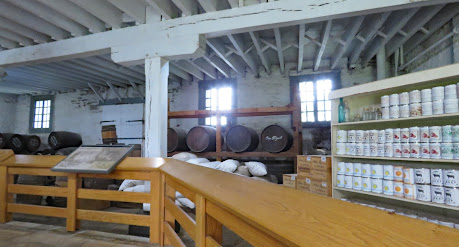Almost eighty years of history are covered by the museum exhibits and the interpretive signs located on the grounds. The first fort was built in 1817 to keep peace between the local Osage and the Cherokees who had migrated west as settlers moved into their homelands. This hard to defend location, just a few hundred feet from the Arkansas River, was abandoned in 1824 when a fort was built further west.
In 1838 a second fort was built slightly east of the first fort. The fort was on the border between Arkansas and Oklahoma which had been designated Indian Territory by the federal government. Dozens of tribes were forced to move from their homelands to the plains of Oklahoma. The fort was never needed for defense and became a supply post for the Native Americans and the forts located further west. It was captured and occupied by the Union forces during the Civil War.
At the end of the Civil War the fort became a US Federal Court with Judge Parker in charge. In 1872 the basement of the old enlisted men's barracks was converted to a jail. This proved to be too small and a new jail was built onto south side of the barracks.
Parker became known as the Hanging Judge because he sentenced more than 70 men to death after they were found guilty of rape or murder. He didn't believe in capital punishment and lobbied against it but he didn't have a choice because federal law decreed death sentences for those crimes. The court was busy because they ruled on crimes committed in the town of Fort Smith, all of western Arkansas, and also Oklahoma. The Indian police couldn't arrest or convict US citizens so many criminals thinking they would be safe escaped across the border where they preyed on the Native Americans. Over two hundred deputy marshals worked with Indian police to capture the criminals.
It takes at least three hours to see the entire site. It's much more interesting than any of the other fort we've visited from this time period. We started at the loop trail for the first fort. There are a few foundation ruins and interpretive signs along the trail.
Another trail circles the grounds of the second fort with more interpretive signs and stops at the Commissary building and reconstructed gallows.
The museum is located in the barracks/courthouse/jail building. The lower level where the entrance is located goes directly into the basement jail which is very dismal looking.
The upper floor is full of information on the entire history of the fort and the criminals that came before Judge Parker.
Most of the site is accessible. Wheelchair users may need assistance on the trail at the first fort because it has some steep hills.It also crosses railroad tracks where small wheels could get stuck. The trail on the grounds of the second fort is accessible. The museum is all accessible. There's even a special chair to get down the stairs if the elevator is not working. We'd never seen anything like this before and I was tempted to take it out of the locker to see how it worked but instead I just took a peek at it. Here's the website.
Evac Chair It has tractor like treads and looks a little scary in use.















No comments:
Post a Comment